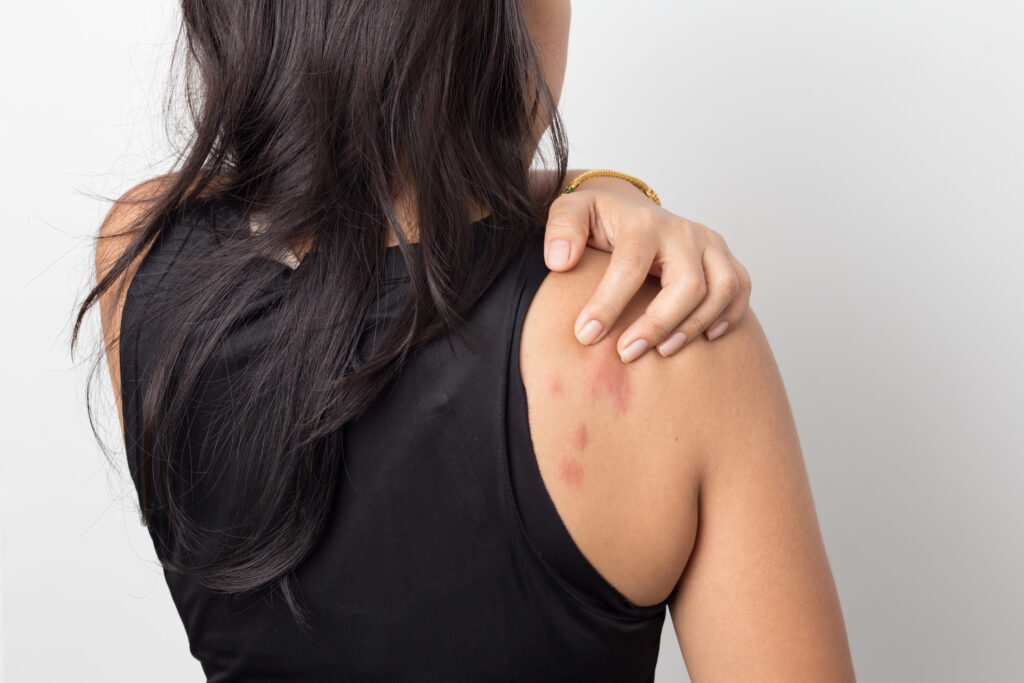Why Do Hives Happen?

Doctors call them urticaria, but you probably know them as hives. Have you experienced hives? They affect about 20 percent of people, and those who are allergy-prone or have sensitive skin are more likely to get them. Most cases of hives are not severe, but that doesn’t mean they’re not troublesome. What causes hives? More importantly, what can be done about them?
- What are hives, exactly? Itchy, raised welts, hives are typically red, pink, or flesh-colored, though they turn white when pressed. They vary widely in size and can be ring-shaped, small and round, or large and randomly shaped. If you’re having an outbreak of hives, don’t be surprised if they change shape during that one outbreak. They are itchy, tend to appear in batches, and can get larger and migrate to different parts of the body. Hives can last less than an hour or for a full day, and they can disappear and reappear during an outbreak. Sometimes they merge into a larger, raised area.
- Are hives dangerous? Most of the time, hives aren’t dangerous. They’re just a temporary reaction that often goes away on its own. If the hives are chronic, though, this is a concern. Seek medical attention if you have hives that last for several weeks, because this may be a sign of an underlying medical condition like celiac disease, lupus, type 1 diabetes, rheumatoid arthritis, or thyroid disease. Sometimes, however, hives can be a true emergency. Seek emergency medical care or call 911 if you have hives in your mouth, on your lips, in your throat, or on your tongue, or experience the following symptoms:
- Trouble swallowing
- Light-headedness or faint
- Swelling in the throat or mouth
- Heart racing
- Why do people get hives? Hives are often an allergic reaction to something like food, medication, insect bites and stings, animal saliva and dander, environmental irritants like pollen, dust, or mold, latex, or blood transfusions. In some cases, though, they’re a response to something else. It could be physical stimuli like sun exposure, cold, heat, pressure, or exercise. Hives can also be connected to illnesses, including viruses, infections, autoimmune diseases, and certain cancers. Sometimes, people get hives from wearing tight clothing or experiencing stress! In some cases, the cause cannot be determined.
- How can hives be treated? Treatment for hives focuses on the goals of controlling the itch, preventing new hives from occurring, and determining the cause so that it can be avoided. Antihistamines can help, and while topical antihistamines and steroids don’t work on hives, your dermatologist can recommend soothing anti-itch cream or lotion. If the hives are severe, your doctor may prescribe a corticosteroid or other medications. Another option for the treatment of hives is light therapy, which is sometimes effective when antihistamines are not. The best way to treat hives is to see your dermatologist and find out the treatment that’s right for you.
Whether you have hives or just you need general help caring for your skin, contact Swinyer-Woseth Dermatology to schedule a consultation. We’re committed to providing superior, professional skin care in a manner that’s practical, efficient, and compassionate. With over 30 years of experience supplying dermatological services in Salt Lake City, we offer a variety of services, from cosmetic skincare to treatment for skin cancer. Our team of board-certified dermatologists and licensed cosmetic service providers are here to provide you the care you need in a comfortable, professional atmosphere. Call (801) 682-4715 or contact us through our website.
